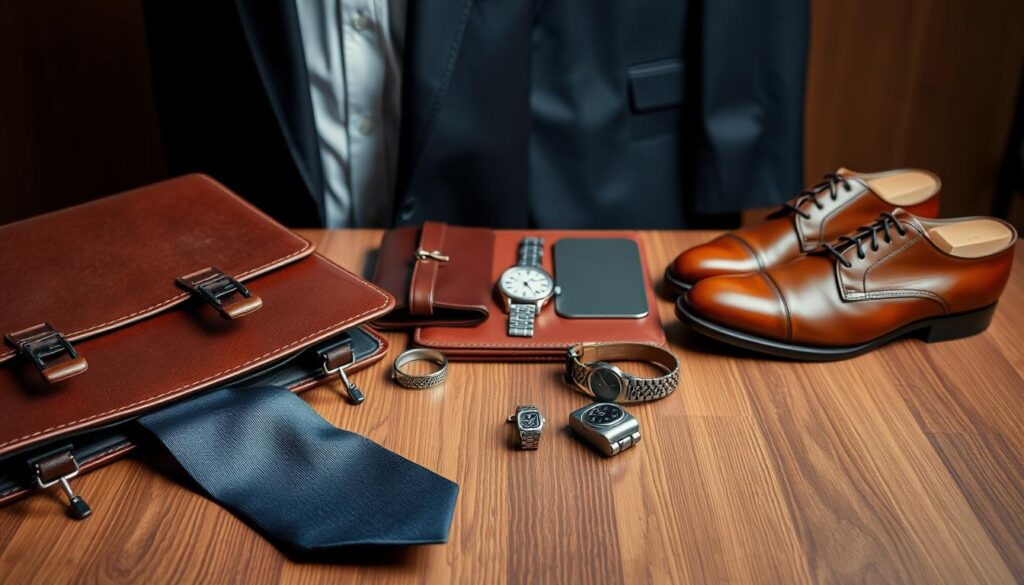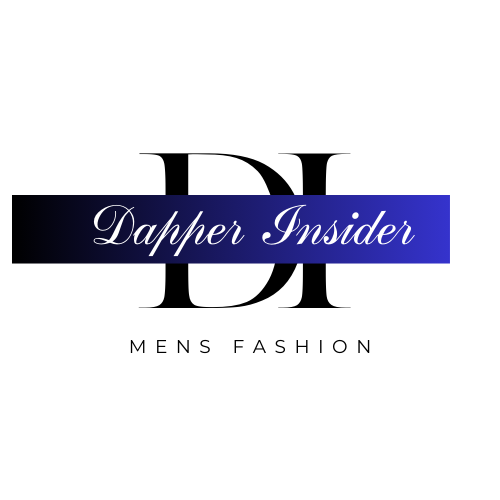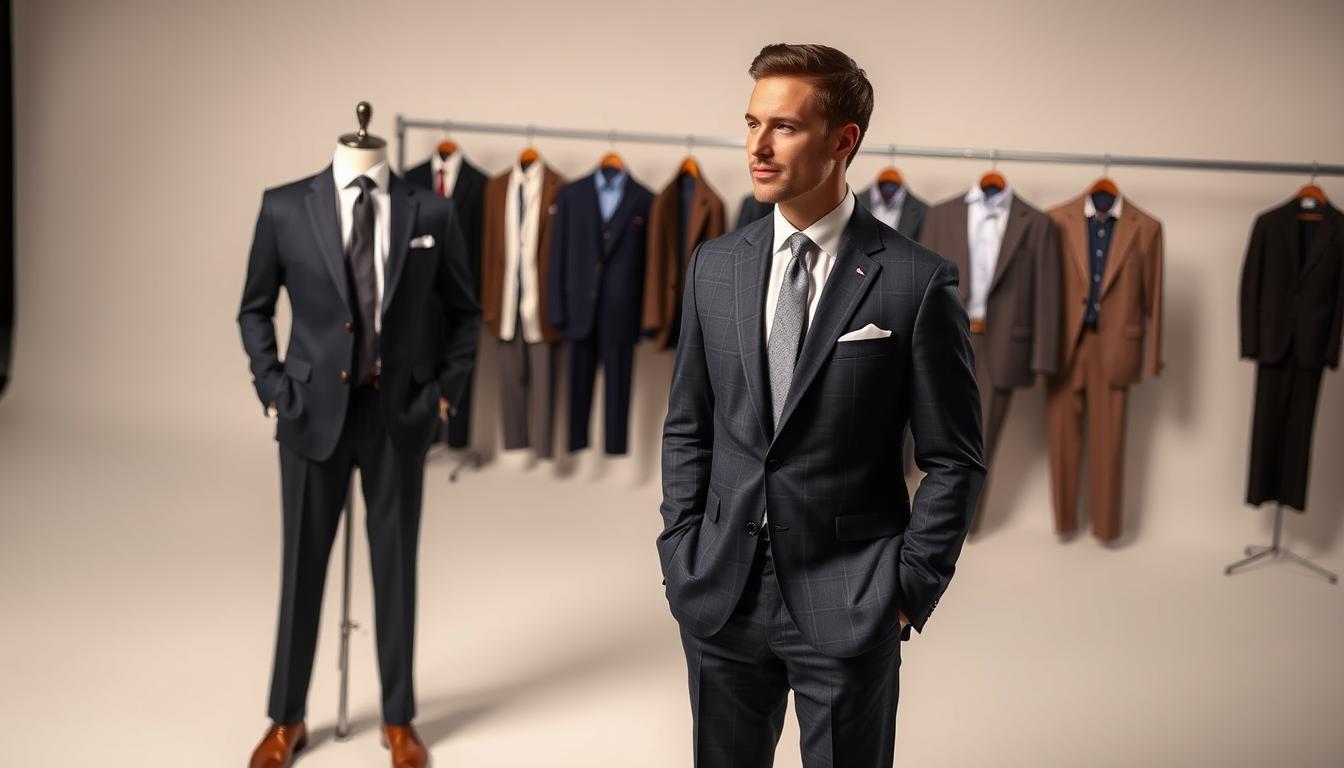Did you know your interview outfit could make or break your chances before you even open your mouth?
How to dress for your next job interview: a men’s guide starts here. Your men’s interview clothing choices speak louder than words. They shape how others see you as competent, confident, and professional. Yet, many candidates overlook this critical detail, relying on outdated styles or generic advice.
This guide covers everything from suits to shoes. It shows how to pick clothes that fit today’s workplace. Learn how small things like fabric quality or color can make a big difference. They can turn a unsure impression into a polished, memorable one.
Key Takeaways
- Your outfit’s first impression can influence hiring decisions within seconds.
- Company culture research is key to avoiding over- or under-dressing.
- Industry-specific tips ensure you stand out in tech, finance, or creative fields.
- Attention to grooming details like hair and nails matters as much as clothing.
- Confidence comes from knowing your clothes fit both the role and the environment.
Why Your Interview Attire Matters
When you walk into an interview, every detail is important. Your job interview attire shows how ready and eager you are. Studies show first impressions are made in under 7 seconds. Clothes play a big role in dressing for success.
First Impressions and Their Lasting Impact
A study by the University of Manchester found 7 seconds is all it takes for interviewers to judge candidates. Here’s what they notice first:
- Clean, pressed suits vs. wrinkled fabrics
- Color coordination (e.g., navy vs. bold patterns)
- Shoe condition and polish
How Your Appearance Reflects Professionalism
Professionalism is more than just following rules. It’s about sending the right signals. A well-tailored suit or crisp shirt shows you care about details. Here’s a comparison:
| Professional Signal | Unprofessional Signal |
|---|---|
| Dark suit with coordinating tie | Jeans or overly casual shoes |
| Neat hairstyle and clean nails | Visible stains or frayed collars |
The Psychology Behind Interview Clothing Choices
Wearing a sharp outfit can also boost your confidence. This is called “enclothed cognition”—clothes affect how we think and act. A Harvard Business School study found people in formal clothes felt more in charge. So, choose clothes that make you feel confident.
“Clothes have the power to shape who we are—and who we become.”
Whether it’s a tailored blazer or a properly knotted tie, each piece of dressing for success tells a story. Start by picking items that show you’re competent and respectful of the opportunity.
Understanding Different Interview Dress Codes
Job interview dress codes can change a lot. Knowing what to wear for each type can make a good impression. Let’s look at the main types so you can pick the right outfit.
- Business Formal: Think tailored suits (navy or charcoal gray), dress shirts, and conservative ties. This is standard for legal, finance, or corporate roles.
- Business Professional: Suits or sport coats with slacks and collared shirts. A belt, leather shoes, and minimal jewelry work here. Best for traditional industries like healthcare or education.
- Business Casual: Khakis, polo shirts, or blazers without ties. Ideal for tech startups or creative agencies where formality is relaxed but still polished.
- Smart Casual: Tweed jackets, linen shirts, or loafers. Perfect for roles in hospitality or real estate requiring approachability without sloppiness.
Interview attire for men must also adapt to your field. Tech firms might prefer navy chinos and button-downs, while law firms require full suits. Research the company’s website or LinkedIn profiles to gauge norms. A key rule: When in doubt, err slightly more formal than casual.
“Your clothing is a silent resume page,” says career coach Emily Carter. “It shows you understand industry standards.”
Pay attention to fit and fabric quality. Avoid extremes like overly flashy accessories or wrinkled garments. These details matter as much as the overall style choice.
How to Dress for Your Next Job Interview: A Men’s Guide
Choosing the right interview outfit starts with research. Use these professional outfit tips to align your style with the job’s requirements:
Assessing the Company Culture Before Your Interview
Research the company’s style by:
- Reviewing LinkedIn profiles of current employees
- Checking the company’s social media posts
- Visiting the office location to observe what staff wear
Matching Your Attire to Position Level
Adjust your interview outfit ideas based on the role:
| Position Level | Outfit Suggestions |
|---|---|
| Entry-Level | Navy blazer with light gray shirt and solid tie |
| Mid-Level | Custom-fit suit in charcoal or black with a silk tie |
| Executive | Three-piece wool suit with subtle pinstripes |
Industry-Specific Dress Code Considerations
Tailor your look to the sector:
For finance, stick to navy or black pinstripe suits. In tech, a tailored chinos-and-blazer combo works. Creative fields like art allow muted patterns, while healthcare requires neutral tones.
The Foundation of Professional Interview Attire
Creating business attire for men that impresses starts with the basics. Every part, from your suit’s cut to your shoes’ shine, boosts confidence. Let’s explore the key elements for men’s interview clothing that looks sharp and thoughtful.
| Category | Key Details |
|---|---|
| Suits | Choose navy, charcoal, or medium gray in wool or cotton blends. Make sure sleeves and trouser hems hit at the wrist and ankle. |
| Dress Shirts | Go for spread collars for a tailored look. Cotton or silk blends are wrinkle-free. Leave one button undone for a relaxed yet professional look. |
| Ties | Stick to solid or subtle pinstripe patterns. Length should end at the belt buckle. Width: 3-3.5 inches for modern styles. |
| Footwear | Polished oxfords or derbies in black, dark brown, or burgundy are best. Clean laces and soles are essential. |
Suits: Colors, Fabrics, and Fits
Navy, charcoal, and medium gray are classic choices. Wool suits are durable for winter, while cotton-linen blends are better for warmer months. Make sure shoulders fit your body shape—no extra fabric at the cuffs.
Dress Shirts: Selecting the Right Style and Fit
Spread collars are better for framing the face than button-downs. Choose white, light blue, or soft pink. Sleeves should be ¼ inch above the suit cuff. Avoid see-through fabrics!
Ties: Patterns, Colors, and Proper Length
Widths should be between 3-3.5 inches. Solid colors or tiny geometric patterns are safest. Length: tip should land at your belt buckle. Silk ties drape better than synthetic ones.
Footwear That Completes Your Professional Look
Shine is key. Oxfords or derbies in black or dark brown are safest. If heels are scuffed, switch to loafers—just make sure they’re matte-finished. Wear neutral socks that fully cover your ankles.
Business Casual Interview Options
Figuring out what to wear for a business casual interview can be hard. You want to look professional but also friendly. Start with pieces like tailored blazers or sport coats. They give a neat look without needing a full suit.
- Tech startups: navy blazer, chinos, and a crisp button-down shirt
- Corporate roles: charcoal sport coat, dress slacks, and a collared shirt with a subtle tie
- Creative fields: khaki pants, a light-colored polo shirt, and leather belt
Stick to colors like navy, gray, or beige. Stay away from distressed denim, graphic t-shirts, or flip-flops. Add a touch of style with a leather wallet chain or a simple watch.
Try out your outfit the day before. Make sure it’s smooth and your shoes are clean. A well-dressed business casual look shows you’re serious but also fits the company’s style.
Accessorizing Your Interview Outfit
Accessories can make or break your professional image. Even the sharpest suit needs the right details to stand out. Start with basics that add polish without overpowering your look.

Belts, Watches, and Other Essential Accessories
Match your belt leather to your shoes for a cohesive look. Opt for sleek watches—think analog designs over flashy smartwatches. Pocket squares add flair when folded neatly into your suit jacket. Keep jewelry minimal; focus on quality over quantity.
- Belt: Full-grain leather, no oversized buckles
- Watch: Stainless steel or gold tones under $200
- Pocket square: Solid colors or subtle geometric patterns
Portfolio or Briefcase Selection
Your carry-along items matter. Choose a portfolio or bag that matches your industry’s vibe. Tech firms might prefer modern briefcases, while law firms lean toward classic leather portfolios.
| Option | Best For | Key Features |
|---|---|---|
| Leather Portfolio | Corporate/Professional Roles | Organized document slots, polished finish |
| Modern Briefcase | Creative Industries | Lightweight, tech-friendly compartments |
| Structured Briefcase | Traditional Sectors | Timeless design, durability |
When and How to Wear Cufflinks
Cufflinks elevate formal interviews. Only wear them with French-cuff shirts. Choose subtle designs—pearls or monograms work best. Avoid oversized or flashy styles that steal attention from your skills.
- Pair with navy or charcoal suits for tech/finance roles
- Gold-tone metals for warmer complexions
- Practice fastening them beforehand to avoid fumbling
Grooming Tips to Complement Your Interview Attire
Your grooming routine is just as important as your interview clothes. A polished look comes from details like hair, nails, and scent. Here’s how to improve your grooming for dressing for success.
Haircut and Facial Hair Maintenance
Start with a fresh haircut 1–2 weeks before your interview. This lets any changes settle. Use lightweight hair products to avoid greasiness.
If you have facial hair, trim it neatly with clippers. Or, go for a clean-shaven look. Use a pre-shave oil to prevent irritation.
Nail Care and Hand Presentation
- Trim nails straight across and file edges smooth.
- Address hangnails by clipping, not picking, to avoid redness.
- Moisturize hands to prevent dry skin, but avoid overly sweet scents.
- Practice a firm handshake—dry hands first if needed.
Cologne Application: The Subtle Approach
Choose a clean, professional scent. Follow these steps:
- Spray on pulse points (wrists, behind ears) instead of spraying directly on clothes.
- Use 1–2 sprays maximum to avoid overwhelming the room.
- Apply 30 minutes before the interview to let the scent settle.
| Tip | Why It Matters |
|---|---|
| Test scent 24 hours prior | Ensures compatibility with your skin and others’ sensitivities. |
| Avoid floral or strong scents | Citrus or light woody scents align better with professional settings. |
Small details like these make sharp dressing for success complete. They leave a lasting positive impact.
Dressing for Virtual Interviews: Special Considerations
Virtual interviews need a fresh approach to the job interview dress code. Even if the camera only shows your upper body, wear a full outfit. This includes pants or a skirt, as you might adjust your seat or stand.
Start with neutral or muted tones like navy, charcoal, or soft grays. Avoid stark white shirts, as they can wash out on camera. Instead, choose solid colors over small patterns that can cause distracting screen effects.
- Color choices: Test fabrics under your lighting to avoid glare.
- Background synergy: Position yourself in front of a tidy, neutral backdrop to keep focus on you.
- Lighting: Use soft, natural light from the front to avoid shadows.
Practice your professional outfit tips with a screen test. Film yourself using your interview setup to check how colors and fabrics look on camera. Make sure your camera angle shows a clean desk and avoids clutter.
Adjust lighting to highlight your face and outfit without harsh shadows.
“Your virtual setup is part of your appearance,” says career advisor Sarah Thompson. “A well-lit space paired with sharp colors builds instant credibility.”
Remember: virtual interviews blur lines between “on camera” and off. Dress fully, test tech beforehand, and ensure every detail—from shoes to background—reflects your professionalism.
Common Interview Attire Mistakes to Avoid
Even the best men’s interview clothing choices can go wrong with small missteps. Here’s how to spot and fix common errors that might distract from your skills.

Fit Issues That Undermine Your Professional Image
Loose, tight, or mismatched pieces scream carelessness. Check:
- Pants that puddle at ankles or dig into waistlines
- Jacket sleeves covering shirt cuffs
- Shirts gaping at the back or collar
Solution? Tailor garments and prioritize fitted interview outfit ideas that lie flat and move naturally.
Color Combinations to Steer Clear Of
| Avoid | Choose |
|---|---|
| Neon shirts + dark suits | Light blue shirts + navy or charcoal suits |
| Bright red ties with black shoes | Dark gray ties with brown oxfords |
| Striped shirts + patterned ties | Plain or subtle pinstripe suits |
Over-Accessorizing and Other Distractions
Less is always more. Skip:
- Multiple rings, flashy watches, or chunky bracelets
- Strong cologne or perfume
- Visible tattoos or unconventional piercings
Stick to a single dress watch and neutral-hued leather belts. Let your expertise—not your accessories—command attention.
Budget-Friendly Options for Quality Interview Clothing
Building a professional wardrobe doesn’t have to cost a lot. How to dress for your next job interview: a men’s guide shows how to make smart choices. Start with essential items like a navy or charcoal suit. These pieces last for years.
- Buy foundational pieces first: Focus on a well-tailored suit, crisp dress shirts, and neutral-colored shoes.
- Leverage sales and off-season shopping: Look for end-of-season discounts on wool suits or winter coats in summer.
- Explore secondhand stores: Thrift stores often carry gently used suits from brands like H&M or Banana Republic.
- Rent for specialized interviews: Services like Rent the Runway offer formal attire at lower costs.
Alterations can make thrifted or discounted items look new. A $20 tailor’s adjustment can make business attire for men look custom-made. Here’s a sample budget breakdown:
| Category | Budget Option ($100–$200) | Mid-Range ($200–$400) | Premium ($400+) |
|---|---|---|---|
| Suit | H&M or Uniqlo | Tommy Hilfiger or Dockers | Brooks Brothers or Hugo Boss |
| Shirts | Express Essentials | Lands’ End | Joseph A. Bank |
| Shoes | Amazon Basics | Clarks | Allen Edmonds |
Smart shopping means finding value and lasting quality. Mix affordable basics with one premium piece. This way, you can look polished without spending too much.
How to Prepare Your Outfit the Night Before
Getting ready for your job interview the night before boosts your confidence. It also helps you avoid morning stress. Here’s how to make sure you look sharp:
Proper Garment Inspection and Cleaning
First, check each piece of clothing carefully. Look for:
- Stains: Blot spills right away with a clean cloth. Use OxiClean or Shout for tough spots.
- Missing buttons or loose threads: Fix these before they become big problems.
- Fabric flaws: If a garment is damaged, try to replace it.
Follow the care labels for cleaning. Silk and other delicate fabrics might need dry cleaning.
Ironing and Steaming Techniques
Here’s a guide for ironing different fabrics:
| Fabric | Iron Setting | Steam? | Tip |
|---|---|---|---|
| Cotton | Medium | Yes | Use a pressing cloth to avoid burns. |
| Wool | Low | No | Steam from 6 inches away to preserve fibers. |
| Linen | High | Yes | Iron while slightly damp for smoother results. |
Iron dress shirts first, then pants. Carry a travel steamer like the SteamGenie for quick fixes.
Creating a Backup Plan
Have an emergency kit ready with:
- Extra buttons and a needle
- Clear nail polish for emergency thread repairs
- A small travel sewing kit
Keep a spare dress shirt or blazer in your car or bag if you can. These tips help turn small issues into minor problems.
Conclusion
Your interview clothes are key to making a good first impression and showing you’re professional. This guide helps you pick clothes that fit the company culture and your style. It’s not just about looking good; it’s about feeling confident and respectful.
Pay attention to details like clean grooming and well-fitting suits. Simple accessories are good too. This way, you look polished without taking away from your skills. Remember, virtual interviews need the same effort as in-person ones.
Use this guide to find the right balance between style and practicality. Every choice you make shows your dedication to the job. By getting ready the night before, you’ll be ready to show off your skills with confidence.
Interview clothes are just part of getting ready. Good clothes and strong communication skills are key. With this guide, you’re set to tackle any interview with confidence and clarity.

